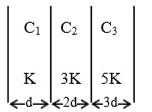Parallel plate capacitors, Solid sphere and Concentric spherical shell capacitor
Step by step video solution for Parallel plate capacitors, Solid sphere and Concentric spherical shell capacitor by Physics experts to help you in doubts & scoring excellent marks in Class 12 exams.
Updated on:21/07/2023Similar Questions
Knowledge Check
You have a parallel plate capacitor, a spherical capacitor and a cylindrical capacitor. Each capacitor is charged and then removed from the same battery. Consider the following situations :
I:· Separation between the plates of parallel plate capacitor is reduced
II: Radius of the outer spherical shell of the spherical capacitor is increased
Ill: Radius of the outer cylinder of cylindrical capacitor is increased.
Which of the following is correct?AIn each of these situations I, II and Ill, charge on the given capacitor remains the same and potential difference across it also remains the same.BIn each ofthese situations I, II and Ill, charge on the given capacitor remains the same but potential difference, in situations I and III, decreases, and in situation II, increases.CIn each of these situations I, II and Ill, charge on the given capacitor remains the same but potential difference, in situations I, decreases, iind in situations II and III, increases.DCharge on the capacitor in each situation changes. It increases in all these situations but potential difference remains the same.In a parallel plate capacitor, the capacitance
Aincreases with increase in the distance between the platesBdecreases if a dielectric material is put between the platesCincreases with decrease in the distance between the platesDincreases with decrease in the area of the platesA parallel plate capacitor is filled with dielectrics. What is capacitance?
 A2K1K2K1+K2BK1K2K1+K2C2ε0Ad(K1K2K1+K2)D2ε0Ad(2K1+K22K1K2)
A2K1K2K1+K2BK1K2K1+K2C2ε0Ad(K1K2K1+K2)D2ε0Ad(2K1+K22K1K2)
The capacitance of parallel plate capacitor depends on the metal used to make the plates of capacitor.
View SolutionA parallel plate capacitor is charged and then isolated. On increasing the plate separation
View SolutionA sheet of copper is inserted in the air gap of a parallel plate capacitor, without touching any of the two plates of the capacitor. The capacitance of the capacitor is
View SolutionIn the reported figure, a capacitor is formed by placing a compound dielectric between the plates of parallel plate capacitor. The expression for the capacity of the said capacitor will be :
(Given area of plate = A)

View SolutionA parallel plate capacitor is charged and then isolated. On increasing the plate separation
View Solution
